9th February, 2024
The Year of The Dragon – The Cusp of a New Cycle
“January 23, 2012 to February 9, 2013 marked the Year of the Dragon. According to tradition, the dragon is the fifth animal in the Chinese zodiac and symbolizes loyalty — it is noble, gentle, and intelligent, but also tactless, stubborn, and dogmatic. “ New York Public Library
2012 was the year a nascent community from different disciplines and interests – IT engineers, journalists, a pharmacist by degree, a librarian, academics, artists, teachers, students, nature lovers, heritage proponents, authors, film makers, lawyers, the tomb keepers, the former residents of the Kampong at Lorong Halwa, a cartographer, descendants of the stones and the local and international media – emerged, each to play their part in generating awareness that there is this 100 year old municipal cemetery called Bukit Brown, that sits in the center of our island where the stones tell stories of the past and the flora and fauna breathes life into it. And the government wanted to build an eight lane highway that will cut Bukit Brown in half, cleaving apart 100 years of heritage, habitat and history.” It is a rare original WWII site that saw one of the last and fiercest battles on the rolling hills of the land.
Chapter I: How it began…..
The first official engagement with the government under the Ministry Of Development went badly. While the Minister was abroad, his senior civil servants were engaging with civil society on a date to meet him. We wanted a consultation and an opportunity to ask what were the alternatives that had been considered.
By the time a date was found – it took about three weeks – the circumstances of the meeting had changed. First there were “outsiders” those in heritage circles but Bukit Brown was not necessarily a priority. This was not the scenario we had envisaged when we met at the Nature Society’s HQ at Geylang. We came from roughly seven different organisations/communities including one newly minted, all things Bukit Brown, feeling their way in tentative steps through civil society.
The response to the meeting or more accurately the briefing by the then Minister of National Development was an immediate media statement calling for a moratorium on the roadworks signed by The Nature Society of Singapore(NSS), The Singapore Heritage Society (SHS), Post Museum, Green Drinks, The Rail Corridor, API, (paranormal group) and all things Bukit Brown.
Both NSS and SHS had led the email negotiations to pin down a date and an agenda to bring up to the Minister. And the way the emails were going, we knew that was a 99 percent chance, we would not get the meeting we requested. Instead the Minister announced the plans from exhumation to construction of the highway in a PPT, with a concession that the whole process would be documented. A suggestion that a heritage advocate had suggested to the CEOs of URA & LTA when they invited him for a morning prata to ask his opinion. It was indeed a prata flip. Aside from the seven groups, there were heritage bloggers, representatives from clan associations, The Peranakan Association government agencies, , the Preservation of Monuments Board and the National Heritage Board.
The fact that seven groups from civil society including the two most established the nature and heritage societies, issued a statement disagreeing at the haste the decision was reached without genuine consultation, made headline news. Bukit Brown was after all, one of our oldest Chinese cemeteries and the mother of all cemeteries with many remains reinterred there because of major developments where they were first laid to rest. Their burial grounds , had made way for HDB estates such as Queenstown, and so in the past time and time again, the dead had to make way for the living. This was different, an 8-lane highway. In today’s context with climate change a critical and existentialist issue, questions would have been raised why are we encouraging car ownership? Could nothing be done with the then Lornie Road, only eight years in existence ? They were raised then, almost prescient. Back and forth, like a ping pong game, with the ball falling into the government’s side of the table in a staccato volley. We were called naysayers, unsympathetic to motorists and asked to offer solutions to solve traffic jams.
Then the government announced that they had taken on feedback and as a concession to civil society realigned part of the highway as a bridge. It was the most natural of realignments as the previous plan would involve building the highway into a valley. What had happened was that the Nature Society of Singapore had submitted the proposal independently to allow space under the bridge for animals to pass and shady plants that did not need much sunlight, It did save a few graves from certain “death”. The concession by the authorities was much lauded in the media as an indication that the government of the day was not recalcitrant and was responsive. With that, the first chapter of our journey came to a close.
Chapter II Letting Go……
Two communities, Post Museum and all things Bukit Brown moved on and forward, to continue to conduct public guided walks to spread awareness, the latter community branched into themed walks such as World War Two at Bukit Brown hooking up with a war archaeologist from the UK, whose family was stationed in Singapore because of his wife’s career. He had found himself living on the doorstep of the battleground around the black and white houses in Adam Road and later explored the Mount Pleasant black and whites the Japanese had occupied. He started to conduct WWII guided walks detailing battlegrounds that covered the Island Club links into Bukit Brown proper including the names of soldiers who are still missing and their last known locations. Their remains may very well lie under the highway – grist embedded in the concrete – even as their names are acknowledged at the Kranji War Memorial.
Outside of Bukit Brown, Post Museum which is an arts group helmed by a husband and wife team, secured a grant for an exhibition held at SAM, the Singapore Art Museum. They were to curate other exhibitions at the Substation and the exhibition space in Bencoolen Street of La Salle College. And they have taken the Bukit Brown “index” to the USA. Days before the exhumation exercise was to start, they arranged a candlelight remembrance and lit up the entrance into Bukit Brown. That entry into the cemetery is no longer, absorbed now into the Lornie Highway.
Particularly poignant in Post Museum’s first exhibition at SAM was an installation where the names of the deceased who had to make way for the highway were written in chalk on a big wall by volunteers and the public, with a photo collage of some of the volunteers at their special/favourite spot in Bukit Brown. The GOH for the opening was Ms Jane Ittogi, the present First Lady who was Chairman of SAM then. Ms Ittogi was to later be the GOH for a brownie event, – brownies, that’s how the community of volunteers under the banner of all things Bukit Brown are known to the public. It was to be a much bigger event over a weekend with exhibitions of artifacts including a letter written in romanised Hokkien, presentations on nature and heritage, and a screening of a documentary, Light On Lotus Hill about the efforts here to assist in logistics in support of the Sino-Japanese war. It was a collaboration with the Chui Hway Lin Teochew Club. It followed very soon after atBB also curated the first exhibition at The Substation partnering the Singapore Heritage Society and the Sub. In the meantime, an 8 part TV series called “History from the Hills” debuted with Bukit Brown as the central space, telling the story of Singapore from pre colonial times to independence. It was to be dubbed into both Mandarin & Malay in years to come.
Along the way, the new kid on the civil society block, picked an award from the inaugural Singapore Advocacy Awards celebrating the best and most promising in civil society. It was more than encourage, it sealed, resolved.
But it was the international media who took up the gauntlet to source alternative views, different angles to the issue The BBC, CNA, and Reuters had correspondents based here. Brownies were interviewed on air and quoted in print. They sent in questions to the government but they had no comment. The Economist correspondent and the family of husband and wife with one young son and a mangy and lovable Singapore special lived near Bukit Brown. They treated Bukit Brown as their backyard and had joined the brownies in their explorations, “bush bashing “ together in areas tight with above and under growth. He blogged it in The Banyan. A Singapore artist and former photojournalist with the local media and her partner, a Pulitzer prize winner for journalism who flew in from New York for the Singapore Writers Festival, arranged to visit the site with brownies and an academic in tow, and somehow managed to gained access to the storage where the tomb artifacts of exhumed graves were stored and snapped a few choice photos. And so that was how Bukit Brown Cemetery and us found ourselves in The New York Times in a feature article.
Chapter III Gaining Traction & The Message in the Bottle
“People with Chinese zodiac dragons born in 2012 have great vision and ambition. In addition, they are full of patience and persistence. Therefore, they can achieve success in their career field easily. They are bold people full of justice and energy, and they like to help people who are in trouble. They have good interpersonal relationships, because they care about friends carefully. They have a unique style and can give everyone an interesting chat when they are in a low mood.”
We are not sure that accurately describes the community but time has proven we are patient and persistent. An application was made to the World Monuments Fund, to have Bukit Brown Cemetery recognised as a historical and heritage site under threat from an impending highway. We got it, the first site in Singapore to gain this recognition. It was for two years 2013 an 2014. When the news broke, most of us were at a temple dinner.
We held a media conference in Bukit Brown and had fairer coverage. Meetings followed with the National Heritage Board, there was to be no u-turn for the highway, so we simply went with tapping grants from the Board, and the result was a book, WWII@Bukit Brown launched in 2016, an anthology of stories with contributions from heritage enthusiasts who charted the military movements from both sides of the divide. And the brownies themselves shared stories they researched and encountered on the grounds of Bukit Brown. But the heart of the book were stories from the descendants whose young men had been taken away by Sook Ching – and the equivalent of a pogrom. It also included other tragic deaths, the story of how an elder sister and also an aunt, was killed by shrapnel from a bomb, protecting her mother, a younger brother and a niece. She was only 19 years old, with a steady boyfriend. The chapter was called “ Lost Promises” And that was exactly what WWII had wreaked on the island, a palpable loss.
We followed the book with Wayfinder@BukitBrown, a curated trail with directional signage and information boards for graves both prominent and poor in easily accessible areas, by pathways and areas where descendants clustered around a set of tombs had their tomb keepers maintain the tombs of the ancestors.
And sometime after Wayfinder was launched, we witness the sea burial of the unclaimed remains of those exhumed for the highway into the waters with a message in a bottle. By sheer dint of fate, a last minute claim was made on the eve by a friend of the brownies, so one less went into the waters. The same waters where their ancestors once sailed through perilous journeys borne by uncertain winds and currents until they reached safe port in “Sin Chew” a sobriquet popularised by the poet Khoo Seok Wan as the “island of stars”; their first glimpse when they arrived at night, the lights from the vessels, necklaced the island. Khoo was himself affected by the highway. The Sun Yat Sen Memorial Hall made a claim for his tomb. So he is memorialised, ironically by his tombstone.
Chapter IV It Won’s be to Long, now ……..
IT WON’T BE TOO LONG: THE CEMETERY (DAWN & DUSK) by Drama Box staged as part of the Singapore International Festival in 2016 made a profound and powerful impact on the community, and gave the brownies both inspiration and validation.
Every year, we get requests from students doing their final papers for interviews or to be part of the documentary projects from Mass Comms students, and the occasional foreign media looking to refresh their stories of the country they have been posted to, just how does a cemetery tick the boxes of community, of heart, of a shared and painful past, of rebuilding, of the forging of a new found identity ? Like patchwork the different threads go into a blanket of stories, still being added to.
Over the years, we have received requests to make presentations from the tertiary institutions such as from the LKYPP, the soon to end Yale-NUS, to complement the walks. From schools to community and adventure groups, opposition parties and establishment, we walked with them and guided in a truly inclusive space. So the public guided walks continue to be our backbone even through lock down as we secured permission from STB, through an intermediary who believed in our efforts and had a long standing working relationship with STB. Boy, did we need the fresh air and sunshine, as we breathed maskless. But we were closely monitored for safe distancing and numbers.
We are thankful that all restrictions have been lifted. In the two years of covid, Bukit Brown was “under maintained”, so parts have grown lusher than before. Slowly but surely tho’ regular maintenance is being implemented as before. Not unusual now to see groups of three or four workers cutting the grass by the paths. So is life back to “normal” now?
Now on a Saturday, if you are lucky you may encounter a trio dubbed as “The Three Amigos” which includes a tomb keeper and sometimes a young warrior woman carrying kilograms of water for cleaning and it is said she keeps the amigos honest. Together they explore Bukit Brown and venture into the adjoining cemeteries of Lao Sua, Kopi Sua and Seh Ong, every Saturday and stop only for the CNY and Xmas holidays or when they are away for work or family. Sometimes they have “guests” with them, they are descendants who have requested assistance locating their ancestors. The reuniting of families to their roots is what keeps them grounded and going, bush bashing, recalling mysteries they encountered that now have answers, and they grow our compendium of a past lives brought into the present. Enough for another book, but that’s for the future. This year we consolidate.
We have been walking – walking the talk – now in a complete 12 year cycle of the Chinese astrological animal, the dragon, the one mythical creature among the twelve. Perhaps, there is something symbolic in that, that holds hope and a promise we are closer to our mission to protect Bukit Brown for future generations; descendants are returning to look for their ancestors, to connect with their roots, more young people are researching their family history, as always we “connect” them to their roots and to us, then back to you when we share their stories online in our FB groups, blogs or in our presentations. A virtuous and vibrant cycle.
As we welcome the new wood Dragon, we are in the process of working on version II of WWII@BukitBrown, It has been six years and during this time we have uncovered more stories and new material has been shared with us exclusively on the Japanese battle plan under General Yamashita including his annotations on the maps of what was to become Synona-to. We are grateful we have this exclusive through the generosity of a private, independent researcher of all things Japanese, who has focused on the war years from primary sources.
And we are relaunching Wayfinder, so coming your way is Wayfinder II. More tombs, more areas covered, to be launched with instagram interactivity. We hope to launch phase one covering the original Hills 1 and 3 with add ons by June’24. The designers have done the first two focus groups to find out what worked, what didn’t and what kind of content independent walkers are interested in.
If you have visited Bukit Brown and would like to take part in the next focus group, please contact our designers thestudiosonder@gmail.com.
Subject: Wayfinder II
Information needed: Name, Age, Gender, phone number and Status: student, working, not working or retired. The information is needed to ensure a representative demographic. If there are too many applications, the designers will only be able to contact you if you fit the demographic, and apologies to those who could not be accommodated this time and thank you!
As always on our big projects we bring in the Singapore Heritage Society to work with us, and they will be with us on the book and the wayfinder. On that pragmatic note, all things Bukit Brown would like to bring you back to what the Year of the Rabbit had visited upon the community. It was a year of realigning back to face- to- face meetings with the National Heritage Board who organised a focus group discussion with the Singapore Heritage Society, all things Bukit Brown, the Nature Society, descendants, the inter government agencies with oversight over Bukit Brown and educators. There is something afoot that would be announced, shortly .
Chapter V Farewell 2023 and Welcome 2024
In 2023, we count our collaboration with Temenggong-Artists-in-Residence, our most productive, enjoyable too, when we participated in their Zhong Yuan (aka Hungry Ghost) Festival. On opening night, their GOH was overheard remarking, “this is a living museum” as he gazed upon the grounds of the black and white houses, perched on a hill facing the old port, resplendent with grave artifacts above and below. Twice, he remarked “this is a living museum” Minister, there is one right in the center of Singapore, still vibrant and teaming with nature and humanity.
The country was galvanised by the Presidential elections. Perhaps the community had a soft spot for President Tharman, who had visited Bukit Brown when he was Deputy and Finance Minister then, with the documentation team and all things Bukit Brown. It was one stormy and lighting flashed afternoon when his entourage arrived. He and his wife Ms Itoggi took shelter at a home of a brownie. We were gratified they returned after the storm calmed, and went with the original itinerary covering four out of five hills. We finished late as the skies darkened and there was no light left ‘cept from our phones. And he asked us a question, and that question gave us hope.
So we look towards the Year of The Dragon with hope and our gratitude to you, our supportive community, we greet you with our very best “Huat” wishes, may the wood dragon not breathe fire unto himself! It means, continue your conversations, discussions and debates on Singapore Heritage – Bukit Brown Cemetery, but be polite and respectful, less the Dragon boots you out.
Be safe, be healthy, wealth in terms of currency ain’t what it’s cut out to bring. It is the prosperity and good fortune of living a virtuous life, lending a hand to those in need, looking out for your neighbour, to be kind – these are rewards within themselves. This is what we have learnt from the stones of Bukit Brown, and they have many lessons yet to give.
Red Stem-fig tree ( Ficus variegata)
Ferns grow close to the ground
An edible fern found at the foot of hill leading up to Ong Sam Leong’s gravesite
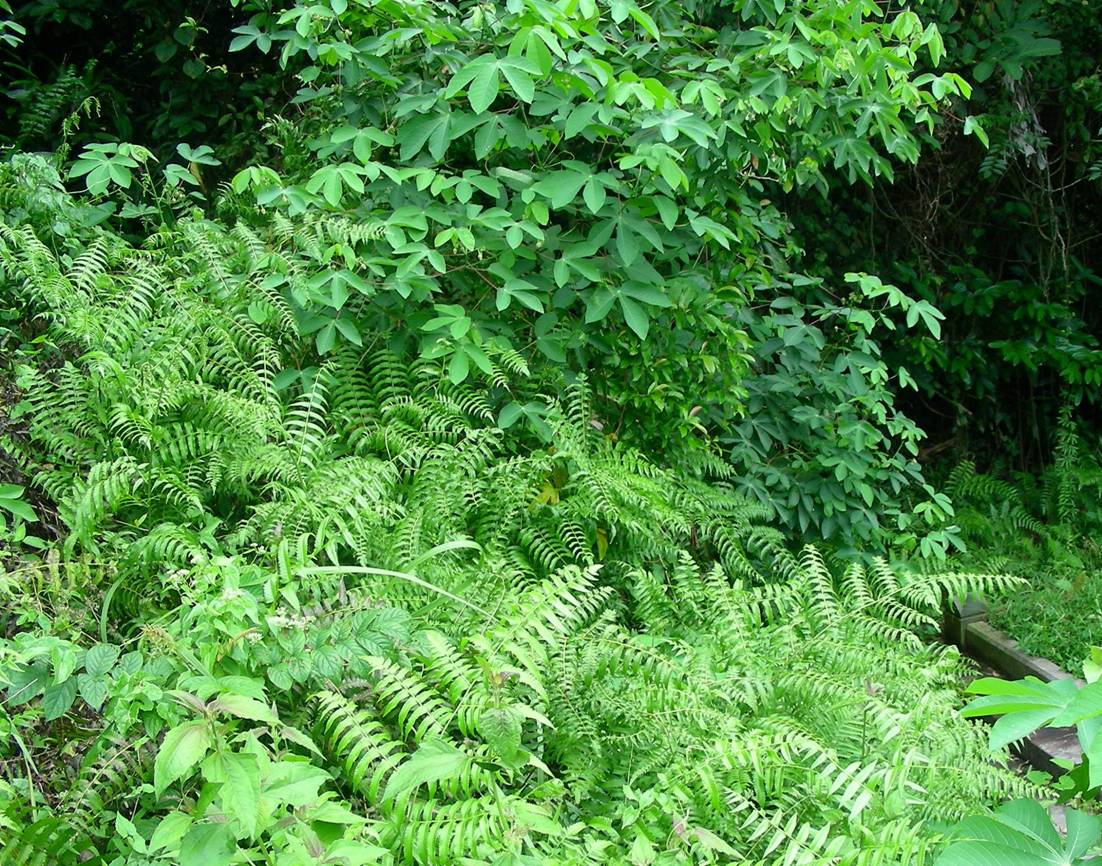
An edible fern, delicious saute with sambal belachan (a Malaysian dish) according to Angie (photo; Angie Ng)
Ferns also grow on hospitable rain trees

This bird’s nest fern in turn hosts a nest for a family of bats. Cuifen who took this photo spotted four. can you spot any?
The False Curry Leaf Plant (Clausena excavata)
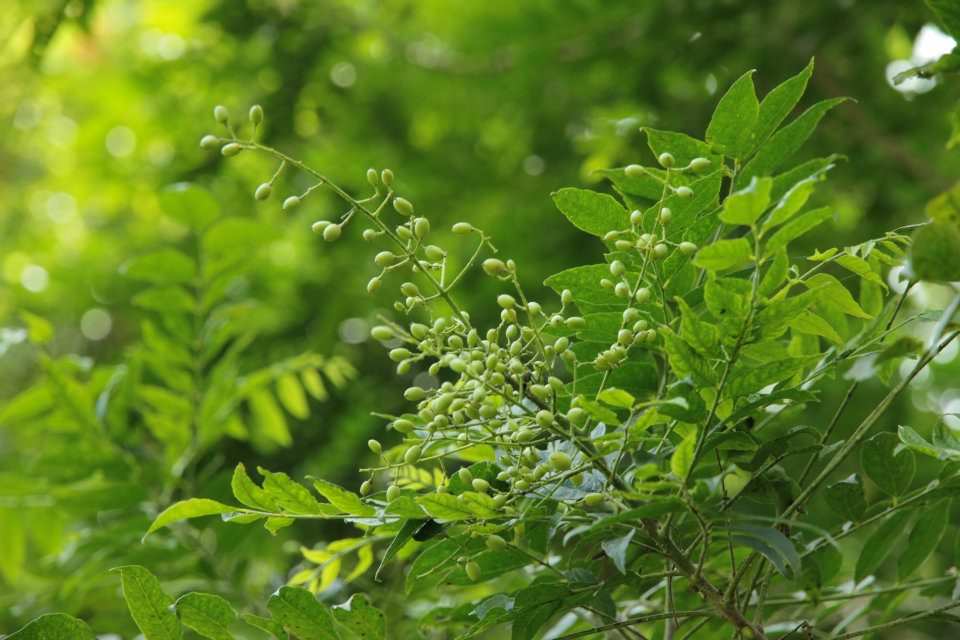
The False Curry Leaf Plant is a small tree which looks like a Curry Leaf plant and whose leaves also smell like it. But its small flowers are in panicles and its green oblong berries ripen pink. (photo Cuifen)
Geophila repens
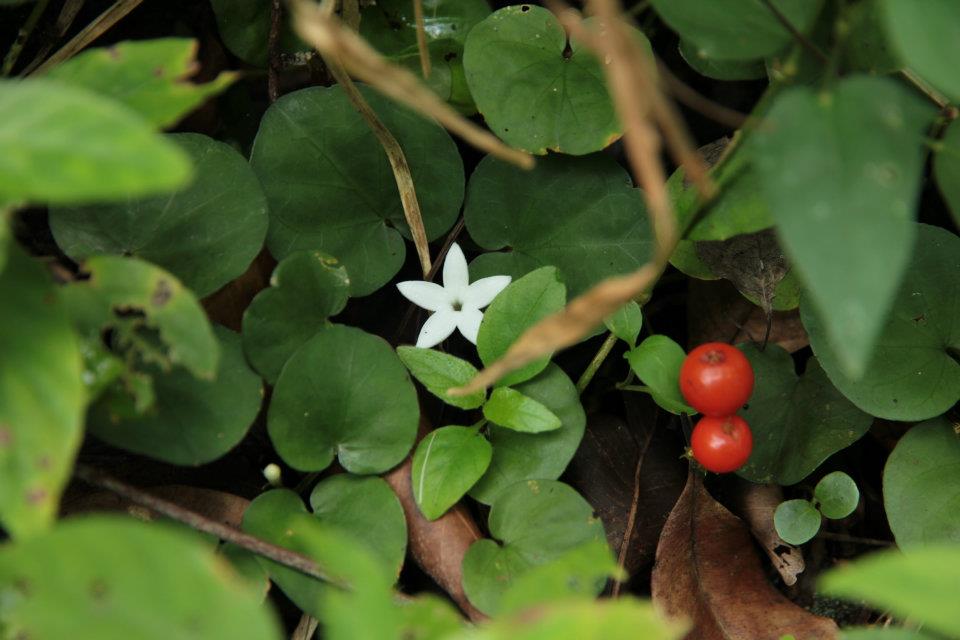
Geophilia repens with tiny white flower and bright red berries creeps among the grasses under shady trees.
Salam Tree ( Syzygium polyanth )

The Salam tree is flowering and dropping bunches of its creamy white stamens. Salam leaves are used to flavour your favourite local breakfast dish, lontong. (Photo: Cuifen)
The Napkin tree
And the most spectacular of the flowering plants : Wild Orchids
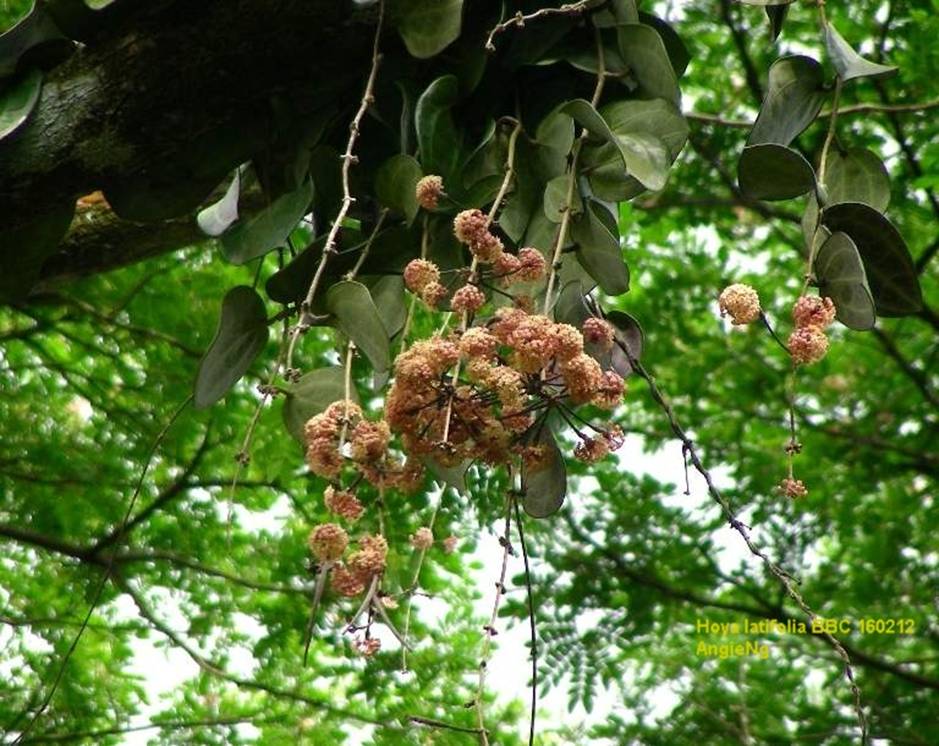
Hoya Latifolia – The waxed flowers hangs high on an old rain tree, leaves are almost heart shaped (photo by Angie Ng)
Read the NSS Position Paper on Bukit Brown
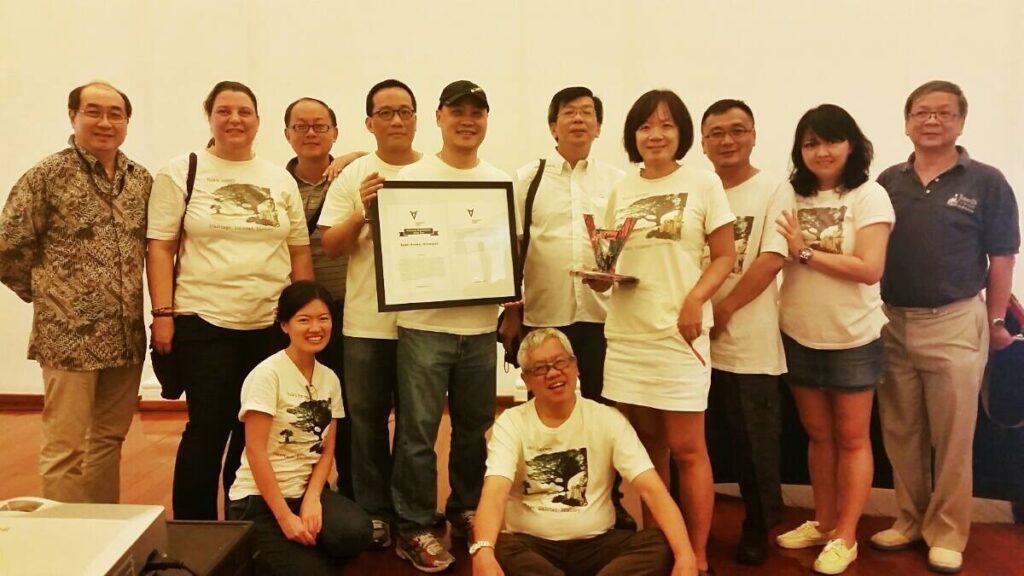
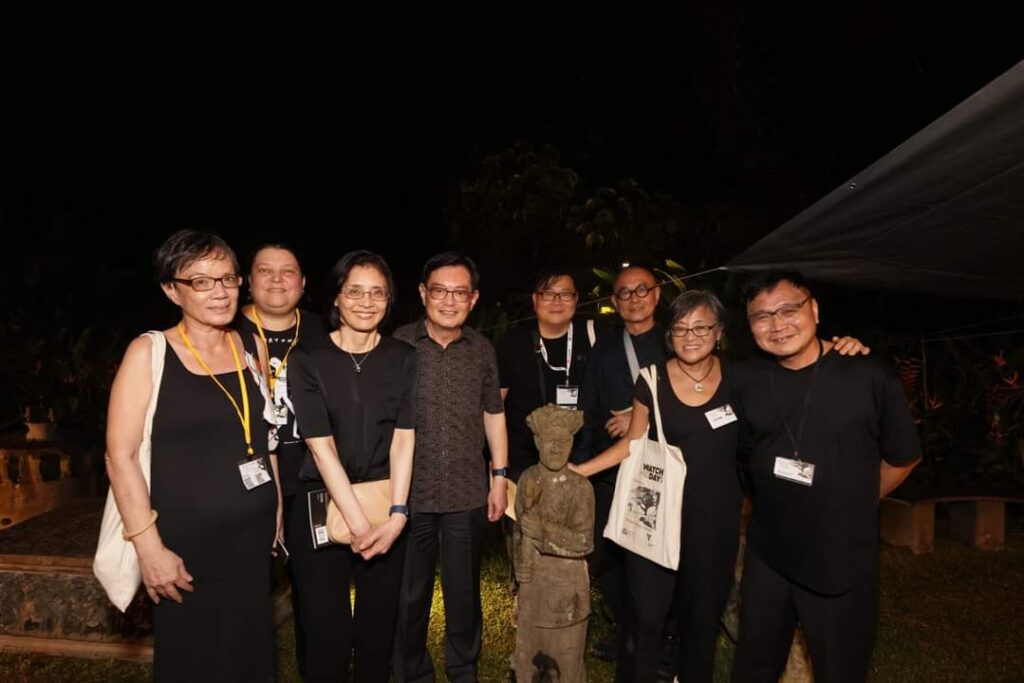
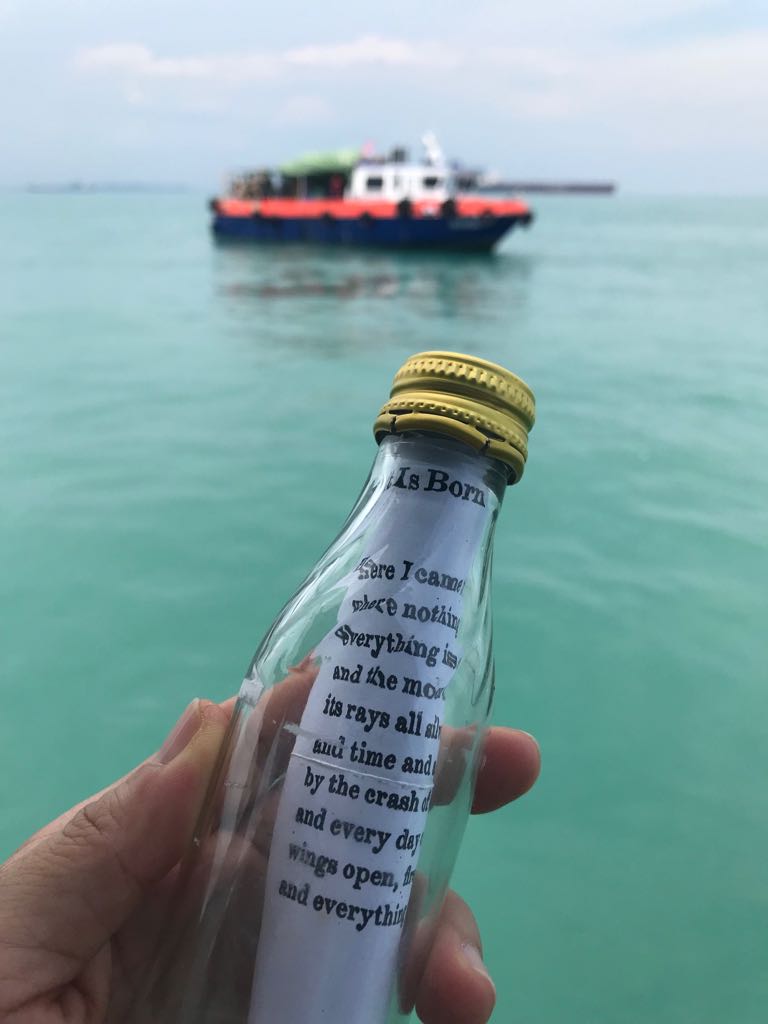

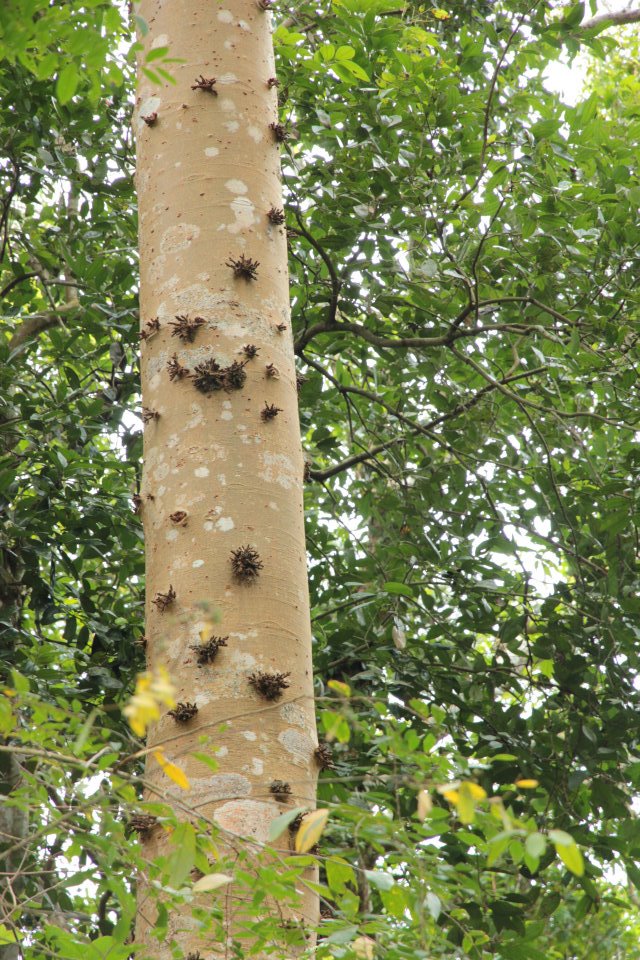



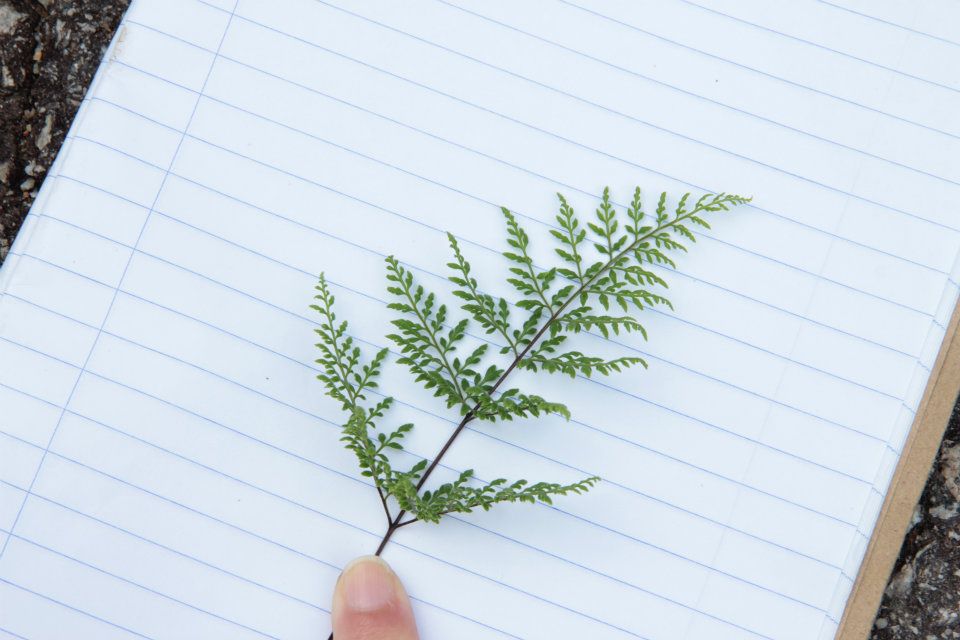
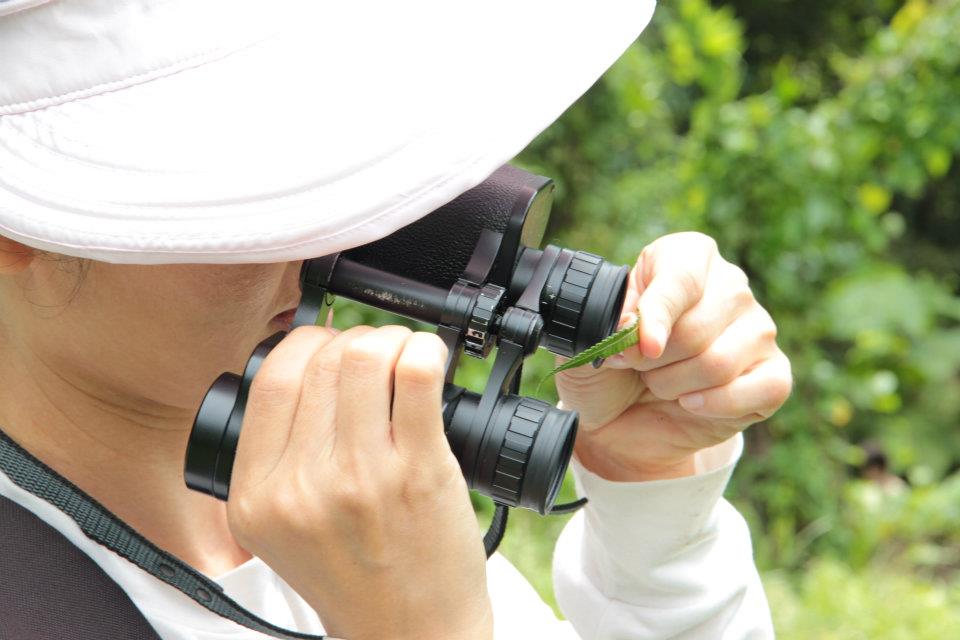

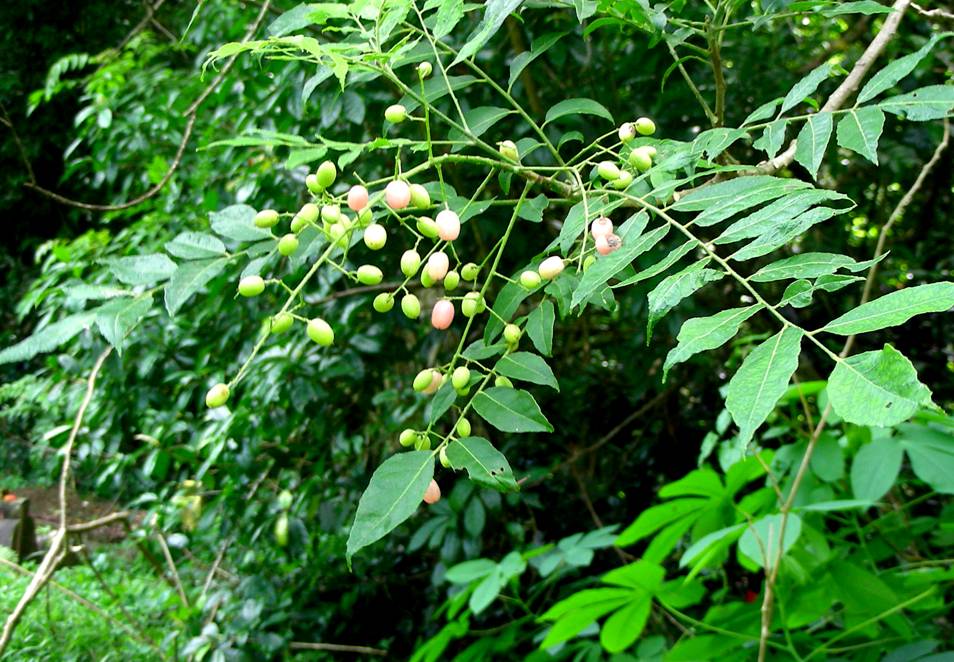


Recent Comments